Germany’s rail system has been making headlines recently, and often not in a good way. Many locals, expats, and tourists have faced the aftermath of train delays, train cancellations, and unexplained absence of trains in many situations. Amidst all this chaos and question of trust with the German train system, one name still rings a mellow bell of relief: ICE train Germany.
With the increasing popularity of cheaper Deutsche Bahn tickets on a subscription basis, getting ICE tickets for travel within Germany has become a low priority. Unless extremely necessary, traveling in regional trains is a good option for many travelers. And that’s ideal too. However, for long-distance travel — in routes like Berlin-Munich, Koblenz-Hamburg — ICE trains are still the top choice for many travelers. And they offer great value.
ICE trains are significantly better than the regional trains, as they offer comparatively more privacy, better facilities and presumably, better civic sense. Personally, I love traveling in ICE trains. It is something to look forward to. So, if you may be wondering how you can make the most out of ICE trains, get some budget deals, and other tips & tricks, you are in the right place. This article will serve as a comprehensive guide for ICE trains in Germany and beyond.
What are ICE Trains?
InterCity (IC) & InterCity Express (ICE) Trains are one of the fastest trains to operate in Germany. ICE trains run at the maximum speed of 220 km/h.
ICE trains mostly run in Germany and a few international routes, such as Switzerland, Austria, France, Netherlands, Belgium, etc. Some of the common and suitable destinations are: Vienna, Amsterdam, Brussels / Bruges, Zurich, Milan, Bolzano, etc.
Their comfort, speed, and better facilities are some of the reasons why travelers prefer ICE trains for their journey. They have a restaurant in the train (albeit expensive) with seating available, comfortable seats, charging ports, overhead and in-seat luggage storage, restrooms, and a good WIFI connection. They offer overall good facilities for a comfortable trip.
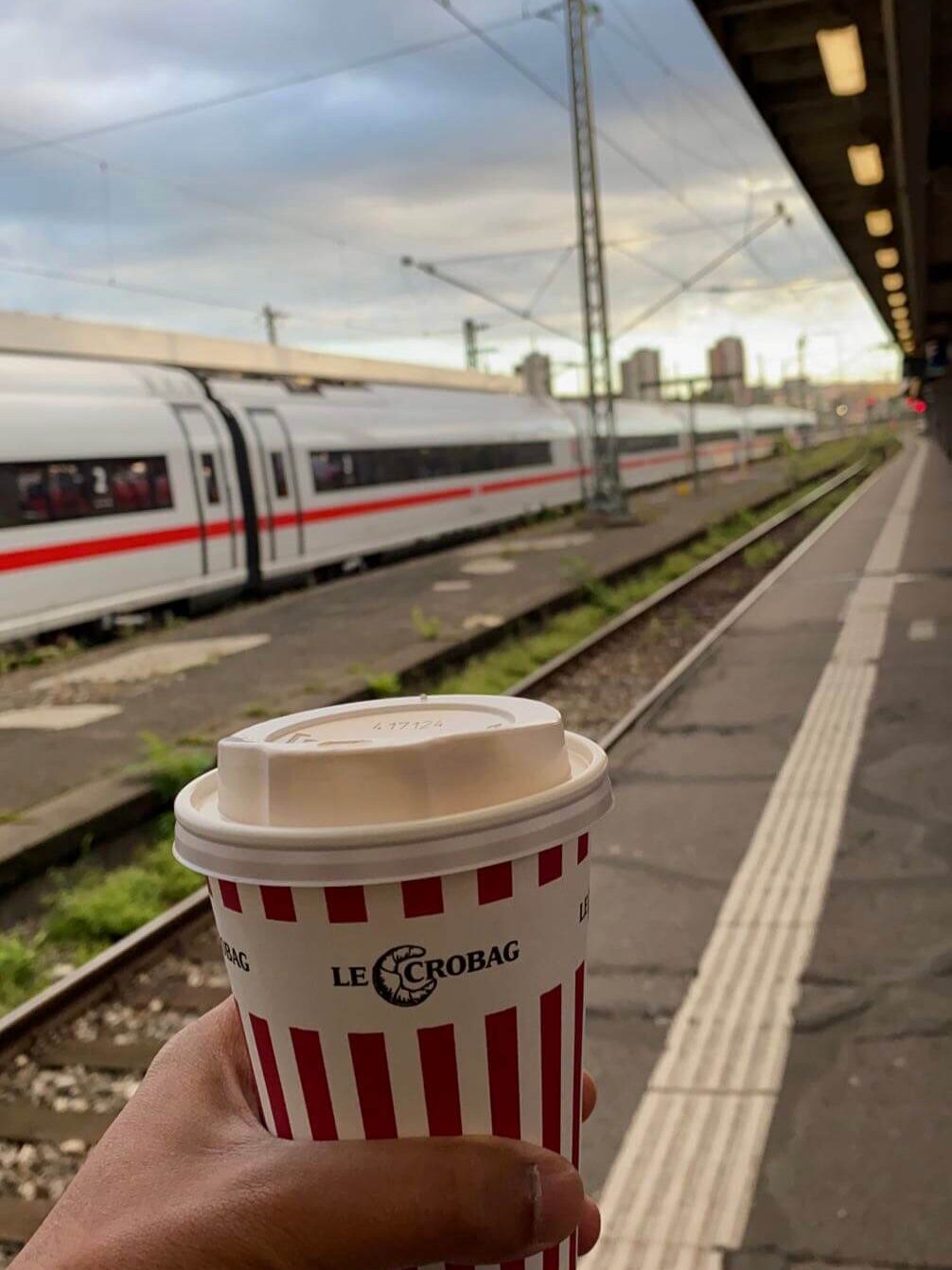
Traveling with: ICE Train Germany
You can book your IC/ICE train tickets using the DB Navigator App. It is helpful to buy the tickets at least a few weeks in advance as the ticket prices start to rise the closer you are to the travel date.
The booking process is simple. When you’re booking, type in the departure and destination, travel date, select second or first class, then hit Search. You will receive a list of options based on the search criteria.
Most important to know in the search results page is to turn the “Show our best prices” filter on. That filter will show you the best price tickets at different times of the day. The late night and overnight tickets are mostly cheaper than the others. If you book early, you can also get daytime tickets for cheaper prices.
Types of ICE Train Germany Tickets
The fares are categorized into Super Sparpreis (Super-saving price), Sparpreis (Saving price), and Flexpreis. Let’s see what they mean.
Super Sparpreis: This ticket offer is the cheapest out of all and comes with a few cons. With this ticket, you can only travel in the specified train and cancellation is not possible after booking.
Note: In the situation of train delays when you are not able to catch the connecting train, the ticket automatically offers unrestricted choice of trains and you can choose any next-available train to reach your destination. When this happens, you will see it in the ticket itself that shows the label “You can now use any train with this ticket”.
Sparpreis: Slightly more expensive than the Super Sparpreis ticket as it offers cancellation subject to a fee (normally 10 EUR). Other than that, it is similar to the Super Sparpreis ticket.
Flexpreis: This ticket is a bit more expensive, about 4 times more expensive than the Sparpreis tickets. It offers unrestricted choice of trains, cancellation free of charge before the first day of validity, and offers a city-ticket for departure and destination.
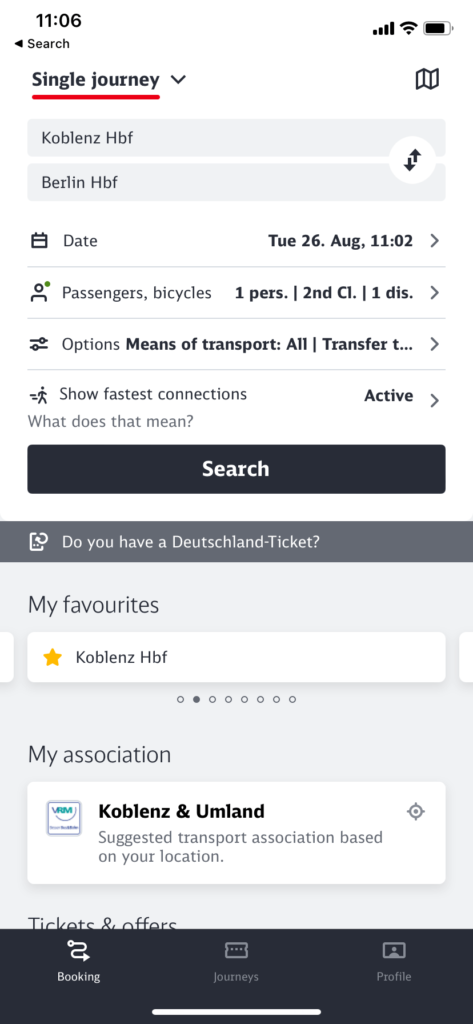
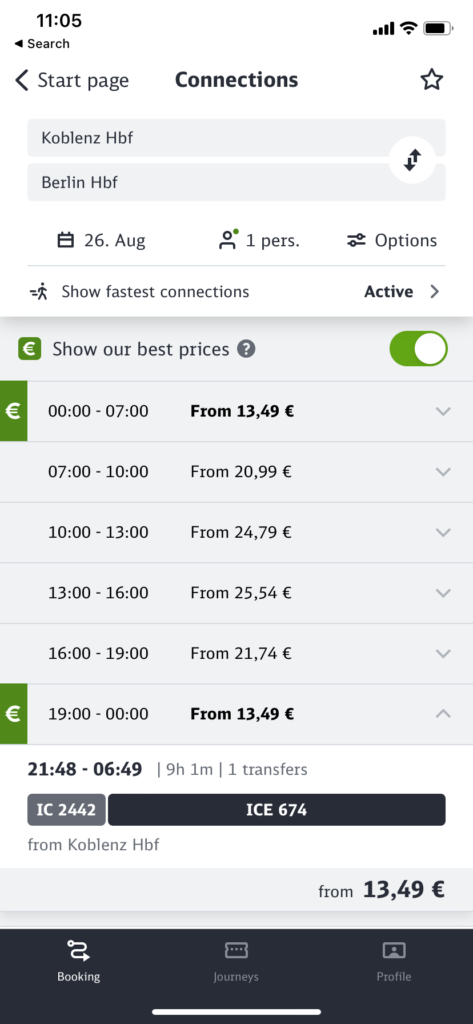
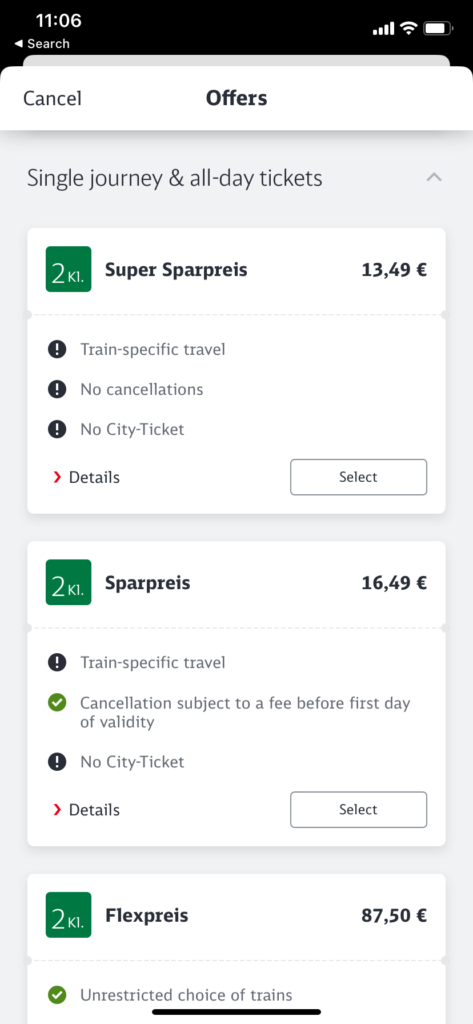
I have only traveled with Super Sparpreis and Sparpreis tickets before and they have worked out well. Flexpreis tickets may be beneficial for some special situations, but I don’t see the value in paying 4 times higher for a train ticket with seemingly similar offerings.
Few tips on booking the best tickets:
- Book the tickets early
- Look out for the promotional offers by Deutsche Bahn. Oftentimes, DB will release additional Sparpreis tickets at a lower price.
Understanding Classes and Seating
Normally, an ICE train will have two classes: first class and second class.
First class tickets will provide access to the first class coaches, which offer better privacy, better seating, and better legspace compared to the second class coaches.
Second class seatings are more standard and may sometimes be crowded if the demand of that specific route is high.
An ICE train ticket does not provide you a seat reservation, you have to reserve that separately at an additional cost (standard seat reservation fee: 5.2 EUR).
So if you have an ICE train ticket and do not have a reservation, you need to manually check each seat to see if they have a reservation and only take the seat if they are available. This can be done by checking the tiny display above the seats which will either be empty or show the reservation.
If it is empty, it means that there is no active reservation and you can sit there. If it has an active reservation, it will show the route section where it is reserved, i.e. Stuttgart – München, Augsburg – München, etc. This means that someone has reserved this seat for the segment of Stuttgart to München and is not available for others.
Normally there are enough seats available even if you do not reserve a seat. I never reserved my seats while traveling in ICE, and only on a few occasions (let’s say, 4 in 100) that I had had trouble finding a seat or had to stand for some part of the trip. Overall, it works out well.
If you have luggage, consider getting a seat near the luggage storage that is available within the coach so you can have an eye on them.
Once you find your seat, don’t forget to do “Comfort check-in”. Through your ticket in the DB app, you can check in your coach number and your seat to make sure that nobody else reserves that seat later. The comfort check-in feature starts a couple of minutes before the train departs the starting location. It is a very efficient way to reserve your seat, so to say, once you’ve boarded the train.
Different Types of Coaches
An ICE train is huge with more than 15 coaches available, so there are a few designated coaches that are helpful to understand.
Quiet zone: These are the quiet areas of the train. If you are taking a seat in this coach, you need to respect the quiet atmosphere. Normally, it is a good civic sense not to disturb other travelers with loud noises and disturbances in other coaches too, but here it has additional priority.
Family zone: As the name suggests, this coach is specially designed for families. If there are no seats available in other coaches, you can take a seat here but it is good to offer the seats to families once they board the train. It’s also worth noting that since it is a family zone, there is going to be some noise. If you wish to sleep or work peacefully, consider taking seats in other coaches.
Bahnbonus gold and platinum zone: This is a special coach whose seats are exclusively “reserved” for the Bahnbonus gold and premium members (more on Bahnbonus and Bahncard later). By “reserved”, it doesn’t mean the seat is already booked by someone, but rather that it’s kept available for BahnBonus gold / premium members to reserve if they choose to.
To see if it is already booked by someone, you can follow the same procedure as earlier, by checking the display on top of the seats. If it is not booked, you are free to take the seat. However, please note that you cannot “comfort check-in” on these seats. So if somebody books this seat and wants it later, you will have to leave it for them.
First class coach: To access this coach, you need to buy a first class ticket. If you sit here with a second class ticket and if the ticket inspector finds out, they will charge you a fine of 60 EUR.
Membership and Reward Systems
BahnCard Membership
Bahncard is a special kind of membership that offers you few additional benefits (including discounts) while booking as compared to the standard travelers. There are many types of Bahncard available, commonly Bahncard 25, Bahncard 50, and Bahncard 100.
Bahncard 25 offers you an additional 25% discount on the tickets. Eg: 24.99 EUR ticket with a Bahncard 25 becomes 18.74 EUR.
Standard price for Bahncard 25 (second class) is 62.90 EUR, while it is only 36.90 EUR for everyone below 27 years old, offered as “My Bahncard 25”.
Bahncard 50 offers you an additional 50% discount on the tickets. Eg: 24.99 EUR ticket with a Bahncard 50 becomes 12.49 EUR
Standard price for Bahncard 50 (second class) is 244 EUR, while it is only 79.99 EUR for everyone below 27 years old, offered as “My Bahncard 50”.
Bahncard 100 offers you free travel throughout Germany. You do not have to buy any additional long-distance tickets.
Standard price for Bahncard 100 (second class) is 4,899 EUR, while it is only 3,199 EUR for everyone below 27 years old, offered as “My Bahncard 100”.
If you wish to travel frequently with the IC/ICE trains, getting a Bahncard is worth the money. I have used Bahncard 25 for more than four years now and cannot recommend it enough. Oftentimes, Deutsche Bahn provides promotional prices to purchase a Bahncard which is almost half the standard price. You can check more information and current offers on their official website here.
Bahnbonus Program
Bahnbonus is a free rewards program offered by Deutsche Bahn. If you book your tickets via your account, you will receive points which you can later redeem for benefits and rewards. Here’s how it works.
- Register for a Bahnbonus account. You can register for Bahnbonus within the DB customer account or you can register with your Bahncard number.
- After every booking you make, you will receive points (1 point per 1 EUR spent) which will be collected in your Bahnbonus account.
- When you have enough points, you can start redeeming them for rewards and benefits.
- Check out for special promotional offers when you can redeem the rewards for much less points.
- Some of the rewards worth redeeming are: 5 EUR train voucher (5 EUR will be reduced from the ticket price), 5 EUR restaurant voucher, etc. I normally wait for promotional offers and redeem these rewards all at once. But be careful that you can only use the voucher within a certain time of redeeming the reward.
- If you own a Bahncard along with the Banbonus account, you can get additional benefits by leveling up your status to Gold and Premium membership.
Smart Travel Tips & Information
- Book early. Booking early is a foolproof way to get a better price on the tickets. At least 3 weeks is a good time to get some savings; the earlier the better.
- Supplement with a Deutschland ticket to maximize savings. Another tip is to use it along with the Deutschland ticket to travel a part of the distance for more savings. For eg: if you are traveling from Koblenz to Berlin, you can book an ICE starting from Cologne and travel to Cologne from Koblenz with a regional ticket. Or, you can travel from Koblenz to a destination earlier from Berlin. This can save you a few Euros. It might be risky at times as the regional trains cannot be trusted completely and if you miss to show up on time, DB is not answerable. However, done thoughtfully, it can help with the savings when needed.
- Get a Bahncard. Bahncard savings pile up over time and if you take at least five to ten trips a year, you will already have saved more than the subscription fee you paid for. Getting a Bahncard during a promotional offer (I bought my latest Bahncard 25 for 44 EUR) is beneficial.
- Pack your food and drinks. In-board restaurant items are very expensive, a light snack will cost you over 6 EUR. Packing your food is especially important for long-distance trips. Unless in an emergency situation or you want some means for relaxation, do not rely on the inboard restaurant.
- Wear layers or carry a shawl. ICE trains can get quite cold, especially at night, and a shawl can double as a light blanket to keep you warm during the trip.
Have you taken an ICE train before? Drop your tips or questions in the comments!
Cover photo by Markus Winkler at Pexels
You might also like the following related posts about Germany.
- Best Things to Do in Oberstdorf, Germany (Year-Round Guide)
- 8 Beautiful Places to See in Bavaria Germany : A Photo Story
- 10 Best Things to do in Rüdesheim am Rhein
- 12 Best Things to do in Koblenz, Germany
- Best Day Trips from Koblenz
- Hike to Nebelhorn Oberstdorf : Your Complete Guide to an Alpine Panorama
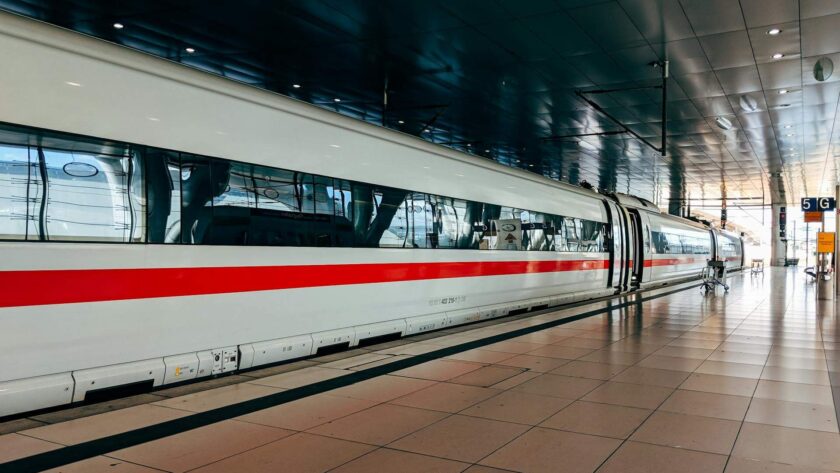



Hope to get similar content in future. Useful for travellers, especially for new comments like me.
Thank you, Niroj. Glad you liked it. I will keep sharing more useful content.